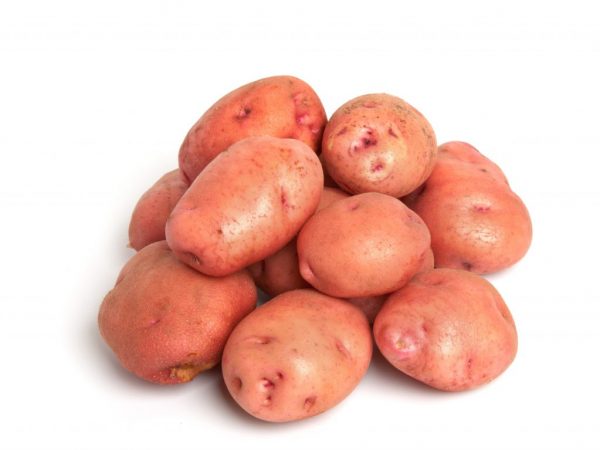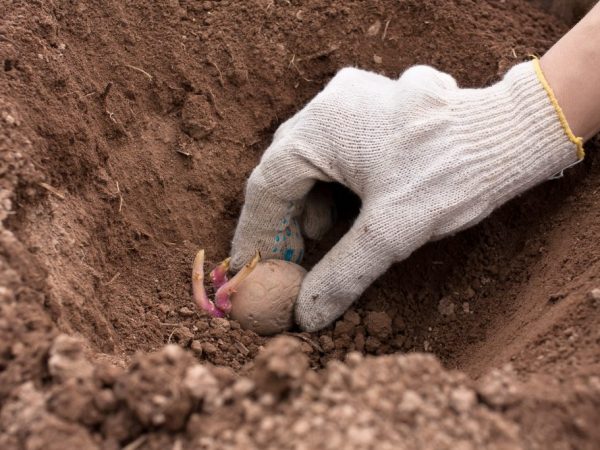Characteristics of the potato variety Bullfinch
Early vegetables on the market are always in price, so summer residents and gardeners are trying to allocate part of the land for breeding early varieties. Bullfinch potatoes gained popularity due to the fact that the first harvest can be harvested in June (even in regions with relatively low average annual temperatures).

Characteristics of the potato variety Bullfinch
The variety of Russian selection was entered in the State Register of the Russian Federation in 2001, it is recommended for breeding in the center and in the north of the European part of Russia, in Western Siberia, in the Urals. The name indicates that the crop is frost resistant.
Description
According to the characteristics of the potato variety Bullfinch, this plant is of medium height. The bush is upright, intermediate type. The tops are bright green in color with a large leaf, there is no waviness at the edge of the leaf. Red-lilac flowers are collected in large inflorescences.
Tubers are round-oval, medium-sized, weighing 60-90 g, with small pink-lilac eyes. The color of the roots is red or pink. The skin is very thin. The pulp is milky white. Up to 15 tubers are tied under the bush. The starch content is slightly above average - about 16%. The digestibility is average. According to gardeners, potatoes have good taste and are suitable for preparing a variety of dishes.
Advantages and disadvantages of the variety
The potato variety Bullfinch has a number of advantages:
- amicable maturation;
- excellent keeping quality - about 95%;
- great taste.
The crop has good yields: for early production - about 200 c / ha, in the period of full ripening - about 350 c / ha. The only drawback of this species is its susceptibility to certain diseases, such as the nematode.
Planting potatoes
Planting rules do not have significant features. The preparation of the soil and planting material is carried out traditionally.
Soil preparation
You can grow a crop on any soil, but loose, nutritious, well-aerated soils provide a higher yield. In order for the land on the site to acquire such properties, it is dug up in the fall to the depth of a shovel bayonet, without breaking clods. Such a procedure not only contributes to the preservation of moisture, better air permeability, but also serves as a means of prevention against certain diseases, a method of pest control. During autumn digging, humus or compost, wood ash and complex inorganic fertilizers are introduced into the soil.
In the spring, the beds for potatoes are loosened if the soil is light, or they are dug again half a bayonet if the ground is heavy, clayey. Fertilizers are applied either during digging, or directly into the holes during planting.
Planting potatoes
A good harvest yields seed material of the superelite or elite category. This allows you to stock up on seeds for 3-5 years.If it is not possible to purchase tubers of this class or grow it yourself, you can use the planting material of the first reproduction, which is sold by agricultural firms at a lower price.

Tubers need to be prepared for planting
You can prepare tubers for planting in this way:
- sort out and discard seeds that are damaged, rotted, scab, etc.;
- 3-4 weeks before planting, place boxes with planting material in a warm, well-lit place for germination and planting; the best characteristics of tubers for planting: the size of a chicken egg and small thick sprouts measuring 2-3 cm;
- immediately before embedding in the soil, treat with agents that increase immunity, because Bullfinch has low resistance to some types of diseases, and insecticides, to prevent pest damage.
Vegetable growers practice pre-planting dusting of tubers with humatized preparations based on wood ash or pour ash into the hole at the rate of 1 tbsp. on the bush.
The culture is planted according to the scheme 60 x 35 cm (the first value is the distance between the holes, the second is in the row between the bushes). Embedding depth - 8-10 cm.
Potato care
The rules for caring for Bullfinch potatoes presuppose the observance of prerequisites: timely soil moistening, hilling, feeding.
Watering
The variety tolerates short-term drought well, but the yield will be higher if the crop receives enough moisture. In the first time after planting, watering is not necessary: the tuber has a sufficient amount of water and nutrients. Excess moisture can adversely affect seedling quality.
It is advisable to water the first watering 7-10 days after the emergence of aerial shoots. Further, the frequency of watering will depend on the weather conditions. It is not recommended to allow the soil to dry out during the period of bud formation, flowering and tying of tubers. Watering will be effective after hilling, in the aisles. The best time is morning or evening.
The first time they spud young bushes that have reached a height of 10-12 cm. The height of the ridge should be such that 4 true leaves remain on the surface of the earth. The second hilling is at a stem height of 15-20 cm. The quantity and quality of tubers largely depends on this procedure.
Fertilizer
The first feeding is carried out after the first hilling. A complex of nitrogen, phosphorus and potassium fertilizers is used. The variety responds well to fertilization with mullein and poultry droppings. It is advisable to feed the plants after watering.
Organics are usually used in a liquid state, infused for at least a day. The proportions are as follows:
- for mullein: 1 part manure 10 parts water;
- for poultry droppings: 1 part dry matter 15 parts water.
Gardeners estimate the efficiency of using organic matter at 30-50% yield increase.
Pest control
According to the description, for the prevention of late blight of the tops and the defeat of the golden nematode, it is necessary to observe crop rotation, remove weeds in a timely manner, prevent moisture stagnation and provide the bushes with good ventilation. Homemade preparations with milk whey, iodine, garlic, wormwood, potassium permanganate, etc. will also help.
Complex fungicides are suitable for plant treatment. Bazudin, for example, helps against nematodes and wireworms. Ditan, Bravo, Revus are treated for late blight, Alternaria.
Conclusion
Summer residents and gardeners appreciated the excellent taste of Snegir potatoes. Since the first potatoes are dug up after 45 days, the variety is suitable for 2 harvests per season.
Bullfinch's tolerance to weather conditions allows it to be successfully cultivated in Siberia. The variety has shown efficiency for small farms.


